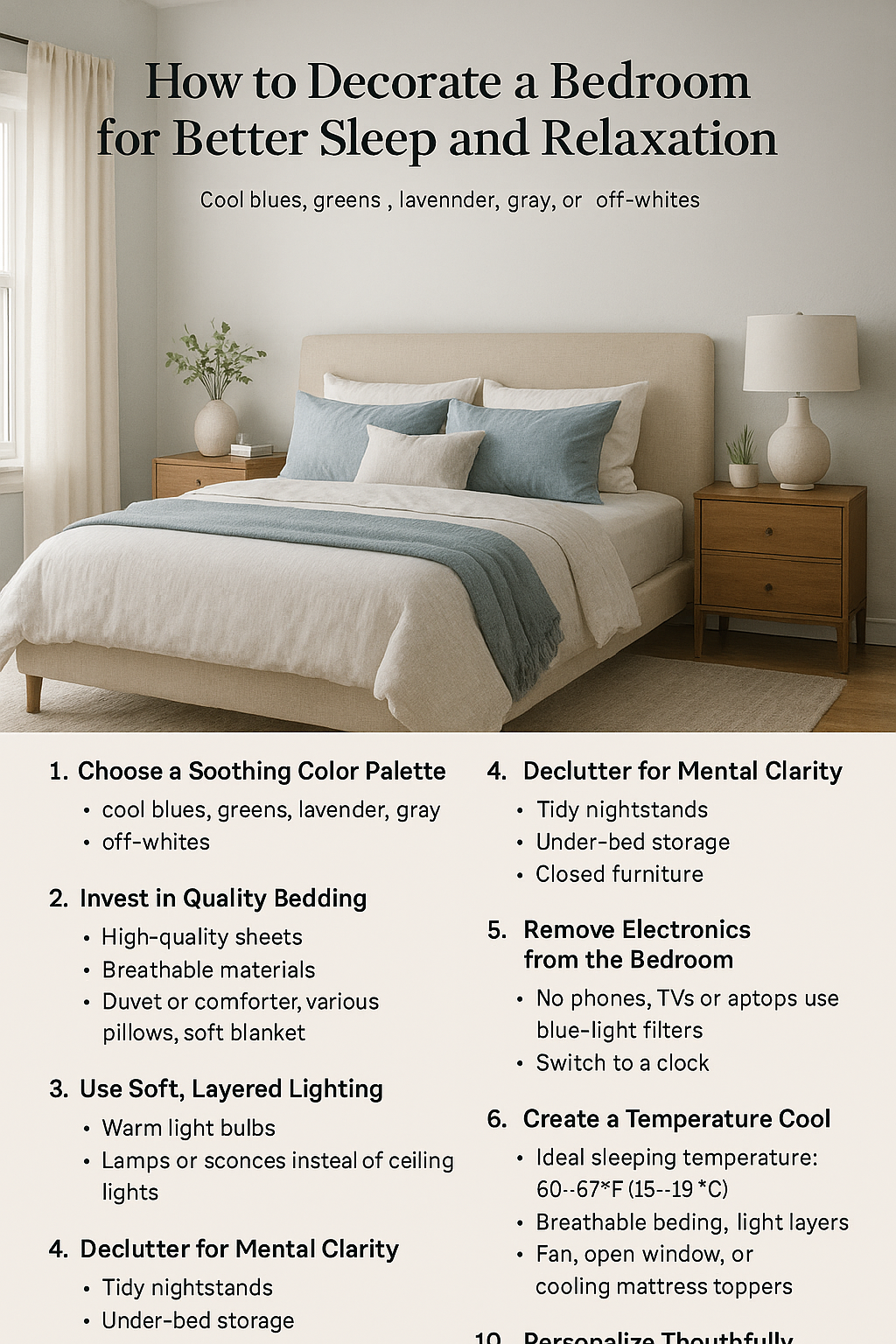Your bedroom should be more than just a place to sleep — it should be a calming retreat where you can relax, recharge, and escape the noise of daily life. The way you decorate your bedroom plays a huge role in the quality of your rest and overall well-being.
In this guide, you’ll learn how to style your bedroom to promote deep sleep, reduce stress, and create a peaceful atmosphere you’ll look forward to every night.
1. Choose a Soothing Color Palette
Color has a strong impact on mood and sleep quality.
- Stick to cool, calming colors like soft blues, greens, lavender, gray, and off-whites.
- Avoid bold, stimulating colors like red or bright yellow.
- Earthy neutrals (taupe, beige, sage green) can create a grounded, cozy feeling.
Tip: Use deeper tones for accent walls or bedding, and lighter tones for a more open, airy feel.
2. Invest in Quality Bedding
Comfort is key when it comes to creating a restful space.
- Choose high-quality sheets with a thread count of at least 300.
- Use breathable materials like cotton, bamboo, or linen.
- Layer with a duvet or comforter, pillows in various firmness levels, and a soft blanket.
Your bed should be the most inviting spot in the room.
3. Use Soft, Layered Lighting
Harsh overhead lighting can disrupt your ability to wind down.
- Opt for warm light bulbs (2700K–3000K) to create a soft, golden glow.
- Use table lamps, wall sconces, or bedside pendant lights instead of relying on ceiling lights.
- Add dimmable bulbs or smart lights to adjust brightness based on the time of day.
Bonus: Use blackout curtains to block natural light in the mornings for deeper sleep.
4. Declutter for Mental Clarity
Visual clutter can lead to mental clutter — especially in your sleeping space.
- Keep nightstands tidy and minimal.
- Use under-bed storage boxes or baskets to hide off-season items.
- Consider closed furniture (like dressers with drawers) instead of open shelving.
Less mess = less stress.
5. Remove Electronics from the Bedroom
Phones, TVs, and laptops emit blue light and keep your brain stimulated.
- Leave devices in another room or use blue-light filters at night.
- If you use your phone as an alarm, switch to a digital or sunrise alarm clock.
- Avoid falling asleep to the TV — it reduces sleep quality and lightens deep sleep.
Your bedroom should be a screen-free zone as much as possible.
6. Add Calming Scents
Scent is a powerful trigger for relaxation and sleep.
- Use a diffuser with essential oils like lavender, chamomile, or sandalwood.
- Try linen sprays on your pillow or scented candles (unlit before bed).
- Use natural scents — avoid overpowering or artificial fragrances.
Soothing smells can help you unwind faster and sleep more deeply.
7. Use Natural Elements
Bringing nature into your bedroom creates a serene, grounded atmosphere.
- Add a small potted plant (like a snake plant or peace lily).
- Use natural materials like wood, linen, cotton, rattan, or stone.
- Include landscape artwork or botanical prints for a relaxing visual focus.
Nature-inspired design has been proven to reduce anxiety and support sleep.
8. Create a Dedicated Relaxation Zone
If you have space, create a small area for winding down before bed.
- A reading chair, floor cushion, or window bench can work well.
- Keep this area free from screens or work materials.
- Add a soft throw, gentle lighting, and maybe a small table for tea or books.
Having a designated “unwind” space helps transition your mind to rest mode.
9. Keep the Temperature Cool
Cooler environments support better sleep.
- Ideal sleeping temperature: 60–67°F (15–19°C).
- Use breathable bedding and light layers to adjust seasonally.
- Use a fan or open a window to circulate air — or invest in cooling mattress toppers.
Comfortable temperature = better quality sleep.
10. Personalize Thoughtfully
While minimalism supports calm, your bedroom should still feel like you.
- Add photos, favorite books, or a piece of art that brings joy.
- Include soft touches like a woven basket, framed quote, or handmade decor.
- Just avoid cluttering surfaces — be intentional with what you choose to display.
A bedroom that reflects who you are will feel like a true sanctuary.
Final Thoughts: Rest Begins with Your Environment
The journey to better sleep starts with the space you sleep in. By choosing calming colors, soft lighting, and cozy textures, and removing stressors like clutter and electronics, you can create a bedroom that nurtures your body and mind.
Remember: your bedroom should work for you — not against you. Treat it as a sacred space for rest, and you’ll wake up feeling more refreshed and ready to take on the day.
